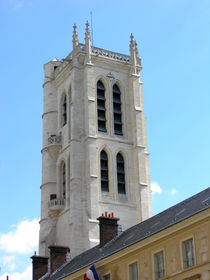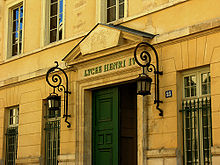- Lycée Henri-IV
-
The Lycée Henri-IV[1] is a public secondary school located in Paris. Along with Louis-le-Grand it is widely regarded as one of the most demanding sixth-form colleges (lycées) in France.
The school has more than 2,500 pupils from collège (the first four years of secondary education in France) to classes préparatoires (classes to prepare students for entrance to the elite Grandes écoles).[1]
Its motto is "Domus Omnibus Una" ("One House For All").
Contents
Buildings and history
Lycée Henri-IV is located in the former royal Abbey of St Genevieve, in the heart of the Latin Quarter on the left bank of the river Seine, near the Panthéon, the church Saint-Étienne-du-Mont, and the rue Mouffetard.[1] Rich in history, architecture, and culture, the Latin Quarter encompasses France's oldest and the most prestigious educational establishments: the École Normale Supérieure, the Sorbonne, the Collège de France and the Lycée Louis-le-Grand.
The abbey was first established in 506; it flourished as a consequence of royal patronage, becoming an integral part of the Sorbonne and housing a great library.[1] The abbey was suppressed during the French Revolution and, in October 1796, the site became the École Centrale du Panthéon, the first of many public schools in France.[1] The lycée has changed its name several times since its inception – École Centrale du Panthéon (1794–1804); Lycée Napoléon (1804–1815); Collège Henri IV,(1815–1848); Lycée Napoléon (1848–1870) and Lycée Corneille (1870–1872) – before its current name was settled on in 1973.[1]
Today the lycée retains many features of the former abbey. The former abbey's library, which had the third largest collection of books in Europe (transferred to the nearby Bibliothèque Sainte-Geneviève during the 19th century), is composed of four aisles forming a cross with a cupola in the intersection. It is one of the main features of the Lycée with its 18th century boiseries and pavement as well as a cupola frescoed and carved by the painter Jean II Restout in the 1730s. Two aisles of the library are now used as libraries for Lycée and Classes Préparatoires levels and the two other aisles are used as rooms for conferences and exams. Another highlight of the lycée is the Salle des médailles (Room of the medals), a long gallery once used as a cabinet of curiosities (a room used to display natural curiosities and artworks). It has richly decorated and carved baroque boiseries and mirrors dating back to 18th century. The chapel of the Lycée dates back to middle-ages as well as the cloister and the Clovis tower, which is perhaps the most famous symbol of the Lycée. The Salle des Actes displays medieval effigies of dead priests of the Abbey which have been found during restoration campaigns in the 1990s. Another feature of the Lycée is the main staircase, named the escalier de la Vierge (Virgin Mary's staircase), which has a 17th century statue of the Virgin Mary as its centrepiece.[1]
The High School
Admissions at Henri IV are very competitive. Prospective students are selected based on grades. Students may come from middle schools throughout France. This cosmopolitan philosophy enables the school to have a large and strong range of cultural values. The education is highly rated and the conditions of work are optimal due to the diverse qualities of the teachers.[citation needed] Henri IV students generally achieve high marks and results for the baccalauréat, with a pass rate of 100% in most years, against a national pass rate of about 80%.[citation needed] The Concours général (national competition for brilliant students) and the examinations to enter the grandes écoles are considered more difficult. Overall, Henri IV provides a high level education due to its rigorous selection process and the quality of its teachers.[citation needed]
Famous alumni
- Henri d'Orléans, Duke of Aumale, governor-general of Algeria, member of parliament, member of the Académie française, the Académie des Beaux Arts and the Académie des Sciences morales et politiques
- other sons of King Louis-Philippe
- Guy Béart, singer
- Léon Blum, French prime minister (of the Front populaire party)
- Jean-Louis Bory, novelist and film critic
- Jacques de Bourbon Busset, co-founder of CERN, member of the Académie française
- Patrick Bruel, composer (who refers to the lycée in his song, «Place des grands hommes»)
- Isambard Kingdom Brunel, British engineer
- Camille Dalmais, singer
- Gilles Deleuze, philosopher
- Léon-Paul Fargue, poet
- Michel Foucault, philosopher
- Paul Fournel, writer and bicyclist
- Georges Friedmann, sociologist
- André Gide, writer
- Julien Gracq, writer
- Georges-Eugène Haussmann, baron, préfet, and city planner
- Alfred Jarry, writer (of Ubu Roi, for example)
- Pierre Loti, sailor and writer
- Jacques Maritain, philosopher
- Guy de Maupassant, writer
- Prosper Mérimée, writer (of Carmen, for example)
- Christopher Meyer, British ambassador to the United States[2]
- Alfred de Musset, playwright and poet
- Paul Nizan, philosopher and writer
- Jean d'Ormesson, novelist
- Mazarine Pingeot, novelist and journalist
- Plantu, cartoonist for Le Monde
- Pierre Puvis de Chavannes, painter
- Éric Rohmer, New Wave director, writer and actor
- Michel Sapin, Deputy Minister of Justice from May 1991 to April 1992, Finance Minister from April 1992 to March 1993, and Minister of Civil Servants and State Reforms from March 2000 to May 2002.[3]
- Jean-Paul Sartre, philosopher
- Maurice Schumann, fellow of the Académie française, minister, and senator
- Jorge Semprún, Spanish Minister for culture
- Bertrand Tavernier, actor, director, producer
- Albert Thibaudet, essayist and critic
- Pierre Vidal-Naquet, historian
- Alfred de Vigny, poet
- André Vingt-Trois, current Archbishop of Paris
- Simone Weil, philosopher
- Fabrice Tourre, Goldman Sachs trader
- Esther Duflo, economist, professor at the MIT, recipient of the John Bates Clark Medal in 2010
- Ali Badou, novelist, journalist and philosopher
Famous teachers
- "Alain", philosopher
- Henri Bergson, philosopher
- Étienne Borne, philosopher
- Jean-Louis Bory, novelist and film critic
- Émile Auguste Chartier, philosopher
- Georges Cuvier, naturalist and zoologist
- Georges Pompidou, French president
See also
Bibliography
- Sophie Peltier-Le Dinh, Danielle Michel-Chich, André Arnold-Peltier, Le Lycée Henri-IV, entre potaches et moines copistes, PIPPA , (ISBN 978-2-916506-16-6) 14€90 (photographs)
Notes and references
- Notes
- Sources
- Robin, Françoise (2011). "Histoire [History]". Paris: Lycée Henri-IV. http://lyc-henri4.scola.ac-paris.fr/lelycee/histoire/histoire.html. Retrieved 25 September 2011.
External links
Categories:- Education in Paris
- Lycées in France
- 5th arrondissement of Paris
- Henri d'Orléans, Duke of Aumale, governor-general of Algeria, member of parliament, member of the Académie française, the Académie des Beaux Arts and the Académie des Sciences morales et politiques
Wikimedia Foundation. 2010.


